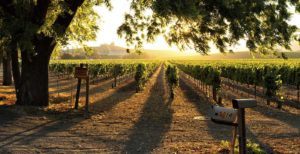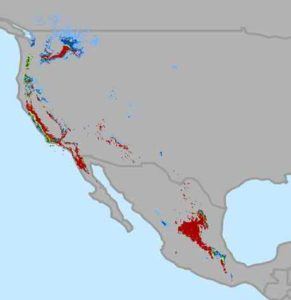The End of Wine? Say It Ain’t So!

Pass the Cabernet! Unless big and immediate action is taken soon, those bold and exciting Californian wines you love so much might just disappear.
In 1976, at a blind tasting held in Paris, some of France’s wine elites judged California wines to be superior to their French counterparts[i]. This “sip heard around the world” changed the trajectory of Californian wines, turning it from a cottage industry into a multi-billion dollar, international powerhouse.

Today, the California wine industry produces nearly 4 million grapes annually, while employing nearly 800,000 Americans and generating $114 billion dollars in annual economic value. The industry attracts nearly 24 million tourists to the state (who then spend over $7 billion) and sells 229 million cases nationally[ii].
Sonoma Valley (located just north of San Francisco) is famous for its rolling hills of award winning wineries and vineyards. One of the reasons the region has been so successful at producing unique and unusual wines, even within California, is the climate. The hallmarks of this climate are a thick layer of coastal fog and a constant, perfect temperature. But as climate change hits the state, that climate has started to change – to a dry, arid and unseasonably warm one.

One of the most famous wineries in this region is Joseph Phelps Vineyards, which was included on the Wine & Spirits Top 100 Wineries of the Year for 2016[iii]. The vineyard’s main location is just 6 miles from the Pacific Ocean because of the specific features of the air (“early morning summer fog is mitigated by cool afternoon breezes coming off San Pablo Bay”[iv]). In addition, Joseph Phelps established the venerable French tradition of goûte de terroir (taste of the soil) which includes “not just the soil, but also the rainfall, drainage, exposure and climate specific to a give [sic] site.”[v]
Moving forward, climate change will have a massive impact on Joseph Phelps Vineyards and the California wine industry as a whole.
- Temperature: Most wines are grown between 54 F and 72 F with some variation in temperature necessary during different parts of the growing season[vi]. Currently, Sonoma Valley averages 50 to 76 F during peak wine months[vii]. As the average temperature continues to rise based on climate change, this region will quickly find itself too hot to produce the traditionally cool weather grapes for which it is famous.
- Rain: As California enters the 5th year of a significant drought (a wet 2015 notwithstanding), wineries will be affected in 2 key ways. 1) The State is severely restricting access to water and levying heavy taxes on offenders which has caused some growers to slow production. 2) The less water the planted vineyards receive, the fewer quality grapes they will produce, leading to wine shortages.[viii]
- Air: While much harder to quantify, Joseph Phelps picked his particular location for the smell of the air, for the way it changes throughout the day and seasons. As the climate changes in California, bringing warmer breezes and fewer foggy mornings, these intangible elements will shift with it, fundamentally changing the flavors of wine.

By 2050, wine production in California is predicted to drop by 70% as the elements above affect the growers’ ability to produce[ix]. However, wine makers are currently enjoying some short-term benefits due to shorter winters[x], which has led none of the top vineyards taking immediate action to protect their future in the state.
There are two crucial steps that vineyards should take to safeguard their future and that of this massive industry in California.
- New Varietals: Not all grapes are created equal here – some are much more resistant to the fluctuations in heat and rain California expects over the next decades. Introduce consumers to them now and build up the expertise so that by the time other wines aren’t an option, California will be able to match the outstanding quality the world has come to expect from it thus far.
- Dry Farming: This forgotten art grows wine without added water, using only what falls naturally and working with the soil to create an environment that traps the water longer. Wineries who have been doing this for decades (i.e. not in response to climate change) assert that it not only cuts water usage drastically but also increases the quality of their wines[xi]. Dry farming will be hard for farmers to implement once vineyards start to fail as the technique requires a deep root system that takes years to develop. Vineyards need to start building the capabilities for this immediately.
At the end of the day, Joseph Phelps Vineyard will be unable to alter or reverse climate change on its own. But unless it begins to adapt – and soon – those bold, exciting California wines we all love will go the way of the dinosaurs and disappear forever.
Word Count: 794
[i] https://www.washingtonpost.com/lifestyle/food/the-wine-tasting-that-shocked-the-world–and-forever-changed-what-we-drink/2016/05/07/39a3e1d0-1082-11e6-8967-7ac733c56f12_story.html
[ii] http://www.wineinstitute.org/files/Wine_Institute_2015_Economic_Impact_Highlights.pdf
[iii] http://www.josephphelps.com/userfiles/file/WS-Top100Wineries2016-2.pdf
[iv] http://www.josephphelps.com/suscol/
[v] http://www.josephphelps.com/vineyards-sonoma-coast/
[vi] http://www.sonomawinegrape.org/sonoma-county
[vii] http://www.usclimatedata.com/climate/sonoma/california/united-states/usca1076
[viii] http://www.salon.com/2014/01/29/bad_news_for_wine_lovers_californias_drought_hits_napa/
[ix] https://www.theguardian.com/environment/2013/apr/08/climate-change-wine-production
[x] http://www.cbsnews.com/news/climate-change-brings-short-term-benefits-long-term-fears-to-california-wine-country/
[xi] https://www.theguardian.com/environment/2016/may/05/dry-farming-california-drought-wine-crops



Joseph Phelps Vineyard wont be able to revert the effects of climate change on its own, but can certainly control its own level of impact and start and industry trend. For example, cork is an endangered species, and its use of one winery won’t change the trend. However, in the same way wineries can influence consumers to try new wine varieties, they can also train consumers on the consumption of sustainable wine. From its agricultural aspect, to its package design and supply chain, the vineyard can rethink wine in light of climate change, and lead the industry change.
The introduction of new wine varieties is interesting to me. I wonder if there are also opportunities to engineer more resilient seeds (or use micro-biomes like we learned about in class) to produce grapes more susceptible to rising temperatures and have a decreased need for water.
That said, I agree with Pablo that it is important for vineyards to take a hard look at their own sustainability practices and ensure they are managing their own level of impact. Cork is a great example – the use of pesticides may be another similar issue for the vineyard to consider.
I found this post to be very interesting and insightful on the Wine industry. It’s clear the industry is facing significant headwinds but that there are also a number of ways they can mitigate the issues they are facing. It is surprising to me that more of the vineyards aren’t coming to terms with the future headwinds and are still simply maximizing profits during these “good” times. The two suggestions above make sense and I wonder what other technological innovations exist in this industry that would further allow it to combat these headwinds.
I was super surprised by the stat: “by 2050, wine production in California is predicted to drop by 70%…”. It seems surprising that with such a dramatic impact over the next 34 years, that more vineyards aren’t currently taking corrective (or rather, preventative) steps. I like your suggestion of introducing new varieties, but I am concerned about the feasibility of getting customers on board. It seems like this could be difficult in industry in which tastes and preferences are so deep-seated and also have a certain social/class structure associated with them. I think in order to successfully employ this solution, they need to get a move on ASAP.
I was shocked when I read that the California wine industry generates $114 billion dollars in annual income, and employees 800,000 Americans! As a non-America, I hadn’t grasp how important this industry is for the country. Regarding your proposal, I agree with the two crucial steps you articulate. However, your first proposal, introducing new varietals, presents a significant dilemma: in order to succeed, will traditional Californian vineyards need to introduce GMOs? If they have not done it, and they decide to do it, how will they market these new seeds to their clients? My initial hypothesis is that this will create a marketing challenge for the most traditional (i.e. old-school) vineyards.
You’ve done a great job proving a very comprehensive analysis of how climate change is affecting wine industry. Being an important industry in California, wine growers and distributors today are facing an unprecedented challenge, and, in my opinion, you’ve broken down the issue in a great way. I enjoyed learning about dry farming and that you candidly called out challenges related to implementing it.